WTO 英文版Communication from the People's Republic of China
- 格式:doc
- 大小:43.50 KB
- 文档页数:3
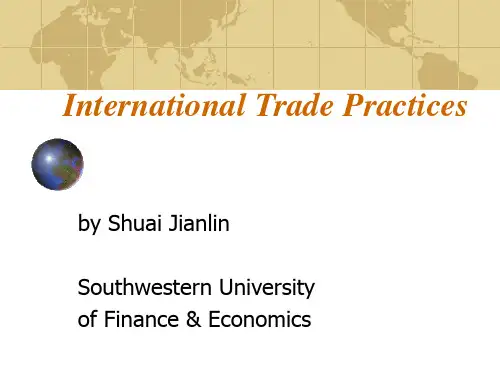
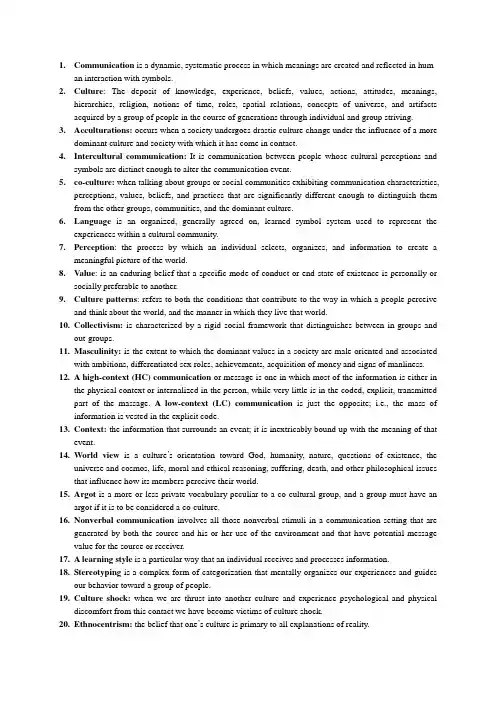
munication is a dynamic, systematic process in which meanings are created and reflected in human interaction with symbols.2.Culture: The deposit of knowledge, experience, beliefs, values, actions, attitudes, meanings,hierarchies, religion, notions of time, roles, spatial relations, concepts of universe, and artifacts acquired by a group of people in the course of generations through individual and group striving.3.Acculturations: occurs when a society undergoes drastic culture change under the influence of a moredominant culture and society with which it has come in contact.4.Intercultural communication:It is communication between people whose cultural perceptions andsymbols are distinct enough to alter the communication event.5.co-culture: when talking about groups or social communities exhibiting communication characteristics,perceptions, values, beliefs, and practices that are significantly different enough to distinguish them from the other groups, communities, and the dominant culture.nguage is an organized, generally agreed on, learned symbol system used to represent theexperiences within a cultural community.7.Perception: the process by which an individual selects, organizes, and information to create ameaningful picture of the world.8.Value: is an enduring belief that a specific mode of conduct or end-state of existence is personally orsocially preferable to another.9.Culture patterns: refers to both the conditions that contribute to the way in which a people perceiveand think about the world, and the manner in which they live that world.10.Collectivism:is characterized by a rigid social framework that distinguishes between in-groups andout-groups.11.Masculinity: is the extent to which the dominant values in a society are male oriented and associatedwith ambitions, differentiated sex roles, achievements, acquisition of money and signs of manliness. 12.A high-context (HC) communication or message is one in which most of the information is either inthe physical context or internalized in the person, while very little is in the coded, explicit, transmitted part of the massage. A low-context (LC) communication is just the opposite; i.e., the mass of information is vested in the explicit code.13.Context: the information that surrounds an event; it is inextricably bound up with the meaning of thatevent.14.World view is a culture’s orientation toward God, humanity, nature, questions of existence, theuniverse and cosmos, life, moral and ethical reasoning, suffering, death, and other philosophical issues that influence how its members perceive their world.15.Argot is a more or less private vocabulary peculiar to a co-cultural group, and a group must have anargot if it is to be considered a co-culture.16.Nonverbal communication involves all those nonverbal stimuli in a communication setting that aregenerated by both the source and his or her use of the environment and that have potential message value for the source or receiver.17.A learning style is a particular way that an individual receives and processes information.18.Stereotyping is a complex form of categorization that mentally organizes our experiences and guidesour behavior toward a group of people.19.Culture shock: when we are thrust into another culture and experience psychological and physicaldiscomfort from this contact we have become victims of culture shock.20.Ethnocentrism: the belief that one’s culture is primary to all explanations of reality.21.Seven characteristics of culture affect communication: learned, transmitted from generation togeneration, based on symbols, dynamic, integrated, ethnocentric, adaptive.22.Belief: our conviction in the truth of something. Learned and subject to cultural interpretation andcultural diversity.23.Individualism:refers to the doctrine, spelled out in detail by the seventeenth. The single mostimportant pattern in the US.24.Hofstede’s Value Dimensions:four parts: individualism-collectivism, uncertainty avoidance, powerdistance, and masculinity and femininity.25.Culture differs in their attitudes toward: individualism and collectivism, uncertainty avoidance,power distance, masculinity and femininity, human nature, the perception of nature, time, activity, relationships, context, formality and informality, assertiveness and interpersonal harmony.26.Religious Similarities: sacred writings, authority, traditional rituals, speculation, ethics.27.Five religious orientations: Christianity, Judaism, Islam, Hinduism, Buddhism.28.the family we are born into the family of orientation and take a spouse the family of procreation.29.problems of translation and equivalence:vocabulary or lexical equivalence, idiomatic and slangequivalence, grammatical-syntactical equivalence, experiential-cultural equivalence, conceptual equivalence.30.The use of argot reflects a co-culture’s need to have a language that permits them to 1.sharemembership,2. participate in their social and cultural communities,3. identify themselves and their place in the universe, 4. communicate with one another about their own social realities.31.Functions of communication: repeating, complementing, substituting, regulating, contradicting.32.The study of how movement communicates is called kinesics. Kinesic cues are those visible bodyshifts and movements that can send messages about 1.our attitude toward the other person 2. our emotional state 3. our desire to control our environment.33.Eyes serve six communication functions: 1. indicates degree of attentiveness, interest, and arousal 2.help intiate and sustain intimate relationships 3. influence attitude change and persuasion 4. regulate interaction 5. communicate emotions 6. define power and status relationships 7. assume a central role in impression management.34.kinds of vocalizations: vocal characterizers, vocal qualifiers, vocal segregates.。
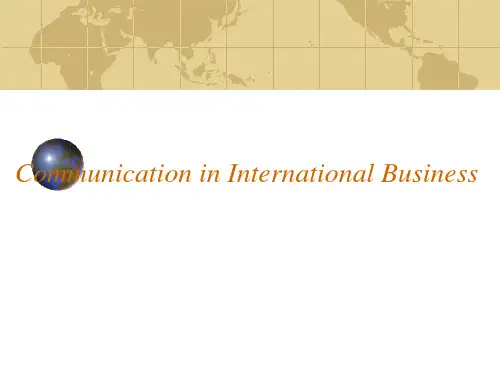
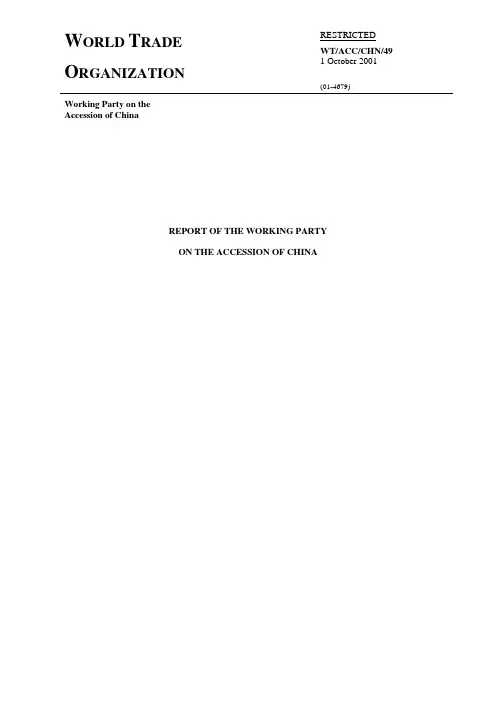
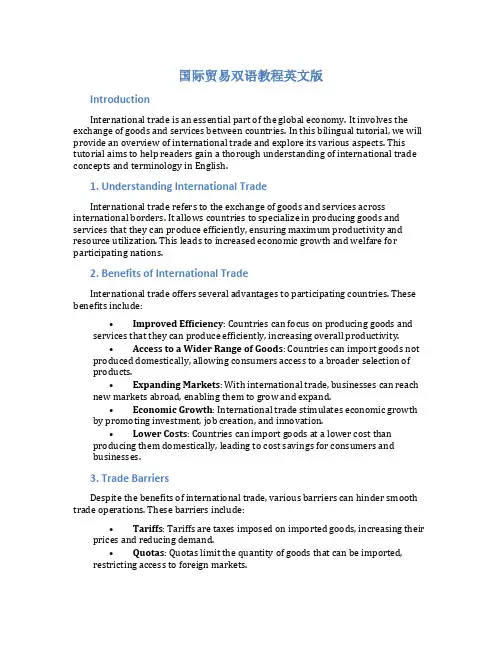
国际贸易双语教程英文版IntroductionInternational trade is an essential part of the global economy. It involves the exchange of goods and services between countries. In this bilingual tutorial, we will provide an overview of international trade and explore its various aspects. This tutorial aims to help readers gain a thorough understanding of international trade concepts and terminology in English.1. Understanding International TradeInternational trade refers to the exchange of goods and services across international borders. It allows countries to specialize in producing goods and services that they can produce efficiently, ensuring maximum productivity and resource utilization. This leads to increased economic growth and welfare for participating nations.2. Benefits of International TradeInternational trade offers several advantages to participating countries. These benefits include:•Improved Efficiency: Countries can focus on producing goods and services that they can produce efficiently, increasing overall productivity.•Access to a Wider Range of Goods: Countries can import goods not produced domestically, allowing consumers access to a broader selection of products.•Expanding Markets: With international trade, businesses can reach new markets abroad, enabling them to grow and expand.•Economic Growth: International trade stimulates economic growth by promoting investment, job creation, and innovation.•Lower Costs: Countries can import goods at a lower cost than producing them domestically, leading to cost savings for consumers andbusinesses.3. Trade BarriersDespite the benefits of international trade, various barriers can hinder smooth trade operations. These barriers include:•Tariffs: Tariffs are taxes imposed on imported goods, increasing their prices and reducing demand.•Quotas: Quotas limit the quantity of goods that can be imported, restricting access to foreign markets.•Regulatory Barriers: These include regulations, standards, and certifications that goods must meet to enter a country, creating additional costs and hurdles for exporters.•Currency Barriers: Fluctuations in exchange rates can affect the competitiveness of goods in international markets.•Trade Restrictions: Embargoes, trade sanctions, and trade wars can further hinder international trade.4. International Trade AgreementsTo promote and regulate international trade, countries often engage in the negotiation and formation of trade agreements. These agreements aim to reduce trade barriers and create a more favorable trade environment. Some prominent international trade agreements include:•World Trade Organization (WTO): The WTO is a global organization that promotes free trade and resolves trade disputes amongmember countries.•Free Trade Agreements (FTAs): FTAs are agreements between countries that eliminate or reduce trade barriers among participating nations.•Regional Trade Agreements (RTAs): RTAs are trade agreements between countries within a specific geographic region.•Bilateral Agreements: Bilateral agreements are trade agreements between two countries, focusing on addressing trade barriers and promoting trade.•Multilateral Agreements: Multilateral agreements involve multiple countries negotiating and establishing trade rules and regulations.5. Trade DocumentationInternational trade involves significant documentation to ensure smooth and legal transactions between parties. Some essential trade documents include: •Commercial Invoice: An invoice that provides detailed information about the goods being sold, including quantity, price, and delivery terms.•Bill of Lading: It is a document issued by a carrier that acknowledges the receipt of goods for shipment.•Packing List: A detailed list of the contents and quantities of a shipment.•Certificate of Origin: It certifies the origin of the goods and is needed to claim preferential treatment under trade agreements.•Insurance Certificate: A document that confirms that goods are insured against loss or damage during transportation.•Customs Declaration: A document that provides information about the goods being imported or exported and helps calculate applicable customs duties and taxes.ConclusionInternational trade plays a crucial role in the global economy, enabling countries to benefit from specialization, economic growth, and improved welfare. This bilingual tutorial aimed to provide an overview of international trade in English, covering its various aspects from understanding the basics to trade barriers, agreements, and documentation. By understanding these concepts, readers can engage in international trade activities more effectively and confidently.。
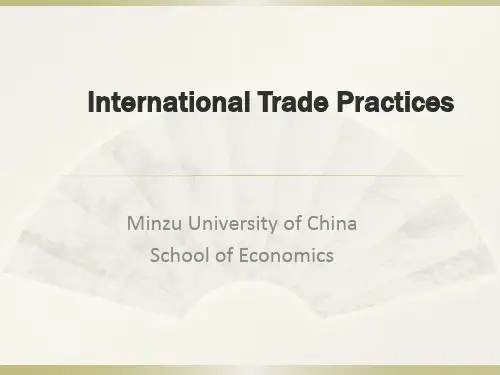
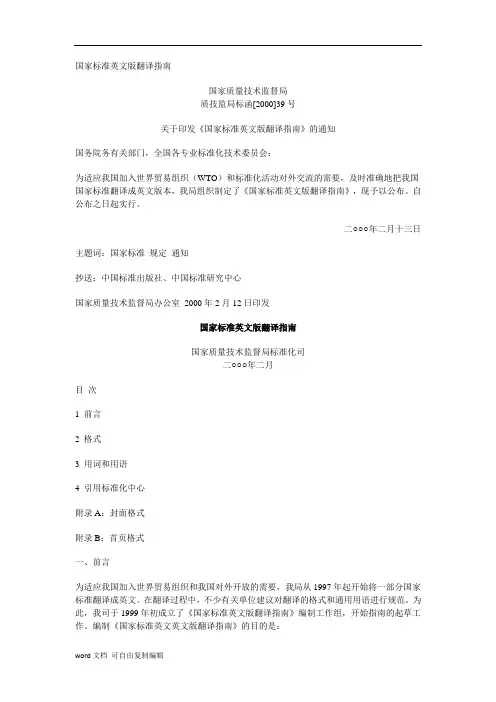
国家标准英文版翻译指南国家质量技术监督局质技监局标函[2000]39号关于印发《国家标准英文版翻译指南》的通知国务院务有关部门,全国各专业标准化技术委员会:为适应我国加入世界贸易组织(WTO)和标准化活动对外交流的需要,及时准确地把我国国家标准翻译成英文版本,我局组织制定了《国家标准英文版翻译指南》,现予以公布。
自公布之日起实行。
二○○○年二月十三日主题词:国家标准规定通知抄送:中国标准出版社、中国标准研究中心国家质量技术监督局办公室2000年2月12日印发国家标准英文版翻译指南国家质量技术监督局标准化司二○○○年二月目次1 前言2 格式3 用词和用语4 引用标准化中心附录A:封面格式附录B:首页格式一、前言为适应我国加入世界贸易组织和我国对外开放的需要,我局从1997年起开始将一部分国家标准翻译成英文。
在翻译过程中,不少有关单位建议对翻译的格式和通用用语进行规范。
为此,我司于1999年初成立了《国家标准英文版翻译指南》编制工作组,开始指南的起草工作。
编制《国家标准英文英文版翻译指南》的目的是:1.对国家标准英文版标准中需要统一的格式进行规范2.对国家标准英文版标准中需要统一的语句和用词进行规范3.对与现行GB1.1及ISO/IEC导则要求有出入的老格式标准文本中有必要进行调整的内容进行规范。
本指南适用于将我国国家标准翻译成英文文本的标准化中心二、格式2.1 等同/修改(等效)采用国际标准的国家标准应使用原英文版本,并符合ISO/IEC指南21(1999版)的要求。
2.2 对于非等效采用国际标准的国家标准,在翻译时应尽可能与原英文版本格式保持一致。
2.3 对于非采用国际标准的国家标准,在翻译时应尽可能以相应国际标准作为格式参考。
2.4 封面和首页格式见附录A和附录B。
三、用词和用语3.1 封面封面用语的英文表述3.1.1 中华人民共和国国家标准National Standard of the People's Republic of China3.1.2 国家质量技术监督局发布Issued by China State Bureau of Quality and Technical Supervision3.1.3 国家技术监督局发布Issued by China State Bureau of Technical Supervision3.1.4 国家标准局发布Issued by China State Bureau of Standards3.1.5 发布日期Issue date3.1.6 实施日期Implementation date3.1.7 等同采用IDT3.1.8 修改(等效)采用MOD3.1.9 非等效采用NEQ3.2 目次目次用语的英文表述3.2.1 目次contents3.2.2 附录annex3.2.3 参考文献bibliography3.2.4 索引index(es)3.2.5 图figure(s)3.2.6 表table(s)3.3 前言前言部分用语的英文表述3.3.1 前言Foreword3.3.2 本国家标准等同采用IEC (ISO) ××××标准: This national standard is identical to IEC (ISO) ××××3.3.3 本国家标准修改(等效)采用IEC(ISO) ××××标准:This national standard is modified in relation to IEC (ISO) ××××3.3.4 本国家标准非等效采用IEC (ISO) ××××标准:This national standard is not equivalent to IEC (ISO) ××××3.3.5 本国家标准附录××××是标准的附录(补充件)Annex ××××/Annexes ×××× of this national standard is/are normative3.3.6 本国家标准附录××××是提示的附录(参考件)Annex ××××/annexes ×××× of this national standard is/are informative3.3.7 本国家标准对先前版本技术内容作了下述重要修改There have been some significant changes in this national standard over its previous edition in the following technical aspects3.3.8 本国家标准与所采用国际标准的主要技术差异The main technical differences between the national standard and the international standard adopted3.3.9 本国家标准从实施日期起代替××××This national standard will replace ×××× from the implementation date of this standard3.3.10 本国家标准由××××提出This national standard was proposed by ××××3.3.11 本国家标准由××××归口This national standard is under the jurisdiction of ××××3.3.12 本国家标准由××××起草This national standard was drafted by ××××3.4 引言3.4.1 引言introduction3.5 范围范围部分用语的英文表述:3.5.1 主题和范围subject and the aspect(s) covered3.5.2 本国家标准规定……的尺寸This national s tandard specifies the dimensions of ……3.5.3 本国家标准规定……的方法This national standard specifies a method of ……3.5.4 本国家标准规定……的性能This national standard specifies the characteristics of ……3.5.5 本国家标准规定……的系统This national standard establishes a system for ……3.5.6 本国家标准规定……的基本原理This national standard establishes general principles for3.5.7 本国家标准适用于……This national standard is applicable to ……3.6 引用标准引语的英文表述(根据中文文本从a, b中选取):a. 下列标准中所包含的条文,通过在本标准中引用而构成为本标准的条文。
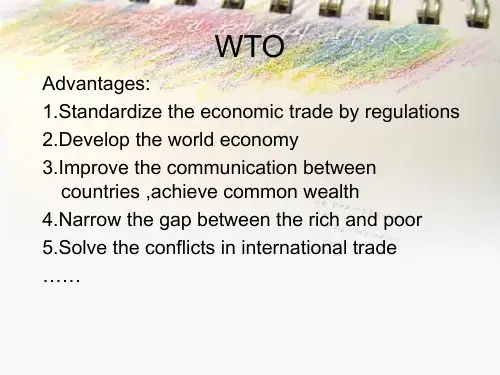
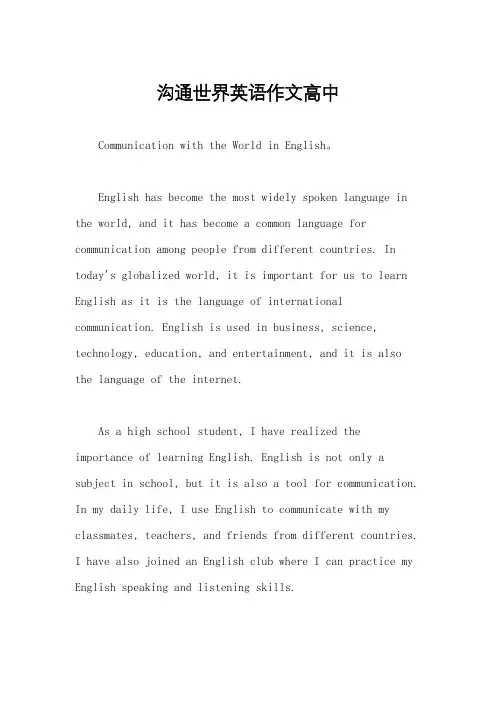
沟通世界英语作文高中Communication with the World in English。
English has become the most widely spoken language in the world, and it has become a common language for communication among people from different countries. In today's globalized world, it is important for us to learn English as it is the language of international communication. English is used in business, science, technology, education, and entertainment, and it is also the language of the internet.As a high school student, I have realized the importance of learning English. English is not only a subject in school, but it is also a tool for communication. In my daily life, I use English to communicate with my classmates, teachers, and friends from different countries.I have also joined an English club where I can practice my English speaking and listening skills.Learning English has opened up many opportunities for me. I have been able to participate in international exchange programs and attend English-speaking universities.I have also been able to read books, watch movies, and listen to music in English, which has helped me to understand different cultures and perspectives.In addition, English has helped me to become more confident and independent. I can communicate with people from different backgrounds and express my ideas and opinions in a clear and concise manner. English has also helped me to become more open-minded and tolerant of different cultures and beliefs.However, learning English is not easy. It requires alot of time and effort to master the language. It is important to practice speaking, listening, reading, and writing in English on a regular basis. It is also important to immerse oneself in the language by watching English-language movies, listening to English-language music, and reading English-language books.In conclusion, learning English is essential for communication with the world. It opens up many opportunities and helps us to become more confident, independent, and open-minded. As a high school student, I will continue to improve my English skills and use it as a tool for communication and personal growth.。
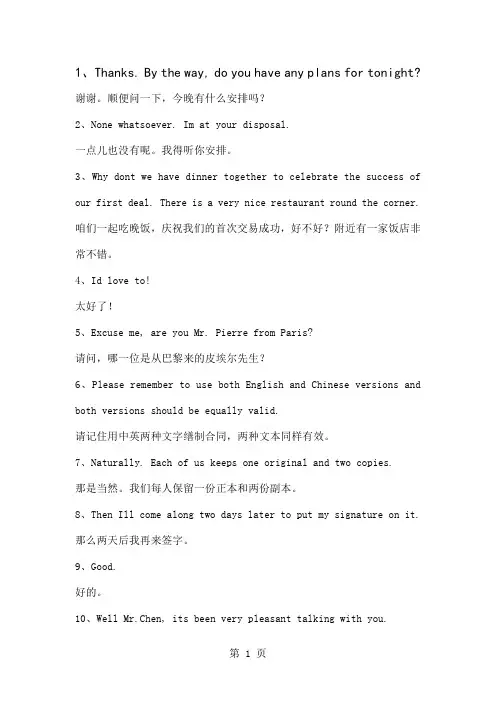
1、Thanks. By the way, do you have any plans for tonight? 谢谢。
顺便问一下,今晚有什么安排吗?2、None whatsoever. Im at your disposal.一点儿也没有呢。
我得听你安排。
3、Why dont we have dinner together to celebrate the success of our first deal. There is a very nice restaurant round the corner. 咱们一起吃晚饭,庆祝我们的首次交易成功,好不好?附近有一家饭店非常不错。
4、Id love to!太好了!5、Excuse me, are you Mr. Pierre from Paris?请问,哪一位是从巴黎来的皮埃尔先生?6、Please remember to use both English and Chinese versions and both versions should be equally valid.请记住用中英两种文字缮制合同,两种文本同样有效。
7、Naturally. Each of us keeps one original and two copies.那是当然。
我们每人保留一份正本和两份副本。
8、Then Ill come along two days later to put my signature on it. 那么两天后我再来签字。
9、Good.好的。
10、Well Mr.Chen, its been very pleasant talking with you.陈先生,跟您谈话真是非常愉快。
11、Your L/C must be opened at least one month before the time of shipment, otherwise we wouldnt be able to catch the ship.你方信用证必须在装货前一个月开出,否则我们将赶不上船。
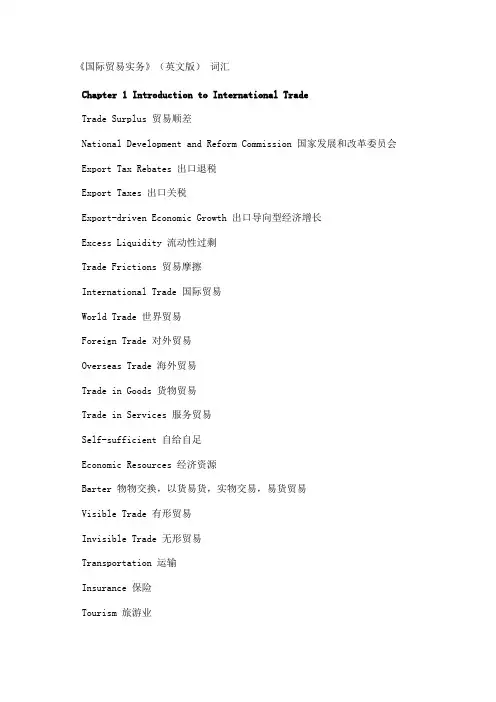
《国际贸易实务》(英文版)词汇Chapter 1 Introduction to International TradeTrade Surplus 贸易顺差National Development and Reform Commission 国家发展和改革委员会Export Tax Rebates 出口退税Export Taxes 出口关税Export-driven Economic Growth 出口导向型经济增长Excess Liquidity 流动性过剩Trade Frictions 贸易摩擦International Trade 国际贸易World Trade 世界贸易Foreign Trade 对外贸易Overseas Trade 海外贸易Trade in Goods 货物贸易Trade in Services 服务贸易Self-sufficient 自给自足Economic Resources 经济资源Barter 物物交换,以货易货,实物交易,易货贸易Visible Trade 有形贸易Invisible Trade 无形贸易Transportation 运输Insurance 保险Tourism 旅游业Balance of Trade 贸易差额A Favorable Balance of Trade 贸易顺差Trade Surplus 贸易顺差An Unfavorable Balance of Trade 贸易逆差Trade Deficit 贸易逆差Balance of Payments 国际收支平衡,国际收支差额A Favorable Balance of Payments 国际收支顺差An Unfavorable Balance of Payments 国际收支逆差International Monetary Fund(IMF)国际货币基金组织Foreign Direct Investment(FDI)对外直接投资,外商直接投资Portfolio Investment 间接投资Chapter 2 International Trade PolicyProtectionism 贸易保护主义Free Trade 自由贸易The National Interest 国家利益Doha Trade Talks 多哈贸易谈判Acquisitions 购并Trade Barriers 贸易壁垒Infant Industries 幼稚产业Tariffs 关税Subsidies 补贴Quantitative Restrictions 数量限制Encouragements 鼓励Import Tariff 进口关税Non-tariff Barriers(NTB)非关税壁垒Export Taxes 出口关税Export Subsidies 出口补贴Protective Tariffs 保护性关税Revenue Tariff 财政关税Specific Duties 从量税Ad Valorem Duties 从价税Compound Duties 复合税Harmonized Tariff Schedule of the United States(HTS)美国协调关税明细表Harmonized System 商品名称及编码协调制度International Harmonized Commodity Coding and Classification System 商品名称及编码协调制度World Customs Organization 世界海关组织Customs Tariff of Import/Export of the People’s Republic of China 中华人民共和国进出口关税条例Import Quota 进口配额Binding Quota 限制性配额Non-binding Quota不具约束力的配额Zero QuotaAbsolute Quotas 绝对配额Tariff-rate Quotas 关税配额Voluntary Export Restraint(VER)自动出口限制Multi-Fiber Arrangement 多种纤维协定Market Failures 市场失灵Domestic Content Requirements 国内成分要求Government Procurement Policies 政府采购政策Buy America Act of 1933 1933年购买美国货法案Red-tape Barriers进口环节壁垒Domestic Supply 国内供给Domestic Demand 国内需求Floor Price 最低限价Shortfall of Supply 供应短缺Export Enhancement Program(EEP)美国的出口促进计划Dairy Export Incentive Program(DEIP)奶制品出口激励项目Chapter 3 Trade Bloc and Trade BlockAsia-Pacific Economic Co-operation Organization (APEC)亚太经合组织Hanoi 河内(越南首都)Stalemate 僵局Open Regionalism 开放的区域主义Trade Liberalization 贸易自由化Most Favored Nation 最惠国Multilateralism 多边贸易Doha Round 多哈回合Free Trade Agreement of Asia and the Pacific(FTAAP)亚太自由贸易协定Free Trade Area 自由贸易区Preferential Trade Agreements(PTAs)特殊优惠贸易协议Bilateral Free Trade Agreements 双边自由贸易协定Discriminatory Tariffs 歧视性关税Tariff Rates 关税税率Trade Discrimination 贸易歧视Trade Bloc 贸易集团Trade Block 贸易禁运EU(European Union)欧盟(欧洲联盟)NAFTA(North American Free Trade Agreement)北美自由贸易协定,北美自由贸易区MERCOSUR(Mercado Comun del Cono Sur)南方共同市场SCCM(Southern Common Markets)南方共同市场ASEAN(Association of Southeast Asian Nations)东南亚国家联盟EFTA(European Free Trade Area)欧洲自由贸易区ASEAN Free Trade Area(AFTA)东盟自由贸易区Customs Union 关税同盟EEC(European Economic Community)欧洲经济共同体EC(the European Community)欧洲共同体Economic Union 经济同盟,经济联盟Trade Embargoes 贸易禁运Economic Sanctions 经济制裁United Nations 联合国Stamp Act 印花税法案Townshend Acts 汤森条例Trade Elasticity 贸易弹性Chapter 4 WTO:A Navigation GuideFranchises 特许经营World Trade Organization(WTO)世界贸易组织Uruguay Round 乌拉圭回合General Agreement on Tariffs and Trade(GATT)关税与贸易总协定Doha Development Agenda 多哈发展议程(多哈回合谈判)WTO Agreements 世界贸易组织协议The World Bank 世界银行International Monetary Fund(IMF)国际货币基金组织Appellate Body 上诉机构Dispute Settlement Panels 争端解决专门小组Plurilateral Committees 诸边协议委员会Ministerial Conference 部长会议The General Council 常务理事会The Dispute Settlement Body 争端解决机构The Trade Policy Review Body 贸易政策审议机构Goods Council 货物贸易理事会Services Council 服务贸易理事会TRIPS Council 与贸易有关的知识产权理事会The Textiles Monitoring Body 纺织品监督机构Heads of Delegations(HOD)代表团首脑The Secretariat 秘书处Sustainable Development 可持续发展Plurilateral Trade Agreement 诸边贸易协定Marrakesh Ministerial Meeting 马拉喀什部长会议(摩洛哥)TRIPS Agreement 与贸易有关的知识产权协定Trade-Related Aspects of Intellectual Property Rights(TRIPS)与贸易有关的知识产权Contracting Parties 缔约国Trade Without Discrimination 贸易无歧视Most-Favored-Nation Treatment 最惠国待遇National Treatment 国民待遇Transparency 透明度Access to Markets 市场准入Navigation Guide 导航General Agreement on Trade in Services(GATS)服务贸易总协定Trade-Related Investment Measures TRIMS 与贸易有关的投资措施Chapter 5 Terms of Commodity——QualityCommodity 商品、货物Manufactured Goods 工业制成品Name of Commodity 货物的品名Description of Goods 货物的名称,货物的描述Quality of Commodity 货物的品质Sample 样品Representative Sample 代表性样品Original Sample 原样Type Sample 标准样品Reference Sample 参考样品Duplicate Sample 复样Sale by Sell’s Sample 凭卖方样品买卖(销售)Sale by buyer’s Sample 凭买方样品买卖(销售)Return Sample 回样Counter Sample 对等样品Sealed Sample 封样The Parties to the Contract 合同的当事人Quality to be about equal to the Sample 品质与样品大致相同Specifications 规格Grade 等级Standard 标准Fair Average Quality(F.A.Q.)良好平均品质Good Merchantable Quality(G.M.Q.)上好可销品质Brand 品牌Trademark 商标Description,Drawing and Diagram 说明书,图纸和技术协议书等Quality Tolerance 品质公差Chapter 5 Terms of Commodity——QuantityQuantity of Commodity 货物的数量Unit of Measurement 计量单位The Metric System 公制The British System 英制The U.S. System 美制Numbers 个数Weight 重量Length 长度Area 面积Volume 体积Capacity 容积International Measurement Conference 国际测量会议International System of Units(SI)国际单位制Gross Weight 毛重Net Weight 净重Gross for net 以毛作净Conditioned Weight 公量Theoretical Weight 理论重量More of Less Clause 溢短装条款Chapter 5 Terms of Commodity——PackingPaking 包装Nude Cargo 裸装货Cargo in Bulk 散装货Outer Packing 外包装Baling 打包Hogsheads 美国橡木桶Inner Packing 内包装Pallet 托盘Shipping Mark 运输标志(唛头)Additional Mark 附属性标志Indicative Mark 指示性标志Warning Mark 警告性标志Neutral Packing 中性包装Neutral Packing with Designated Brand 定牌中性包装Neutral Packing without Designated Brand 无牌中性包装Chapter 6 International Trade TermsL/C Issuing Date 信用证的开证日期Partial Shipment 分批装运Transshipment 转运Shipment 装运Terms of Payment 支付条件Draft 汇票Liner 班轮Trade Terms,Price Terms,Delivery Terms 贸易术语,价格术语,交货术语Warsaw-Oxford Rules 1932 1932年华沙——牛津规则International Law Association 国际法律协会Revised American Foreign Trade Definitions 1941 1941年美国对外贸易定义修正本INCOTERMS 2000 2000年国际贸易术语解释通则International Chamber of Commerce(ICC)国际商会Carrier 承运人Frontier 边境Clear 清关Value added tax(VAT)增值税United Nations Commission on International Trade Law(UNCITRAL)联合国国际贸易法律委员会Ship’s Rail 船舷Quay 码头Multi-modal Transport 多式联运Trim 平舱Stow 理舱EXW 工厂交货FCA 货交承运人FOB 装运港船上交货FAS 货交船边CFR 成本加运费CIF 成本加保险费加运费CPT 运费付至CIP 运费、保险费付至DAF 边境交货DES 目的港船上交货DEQ 目的港码头交货DDU 未完税交货DDP 完税后交货。
你对世界文化贸易交流的看法英语作文My Views on Cultural Exchange Through World TradeHave you ever wondered where all the different foods, clothes, toys and other things we use every day come from? A lot of them are made in other countries and travel very far to get to us! This is called international trade, and it allows different cultures from all over the world to share their unique products, ideas and traditions. I think this cultural exchange through world trade is really amazing!When my family goes to the grocery store, we can find fruits and vegetables from places like Mexico, Chile, New Zealand and many other countries. The bananas we eat likely came all the way from Central America or the Caribbean islands! At home, we have spices in our kitchen cabinets from India, furniture made of wood from African countries, and electronics put together with parts made in several different Asian nations.Even a lot of our clothes and toys are made in other parts of the world before being shipped over here to be sold. My favorite soccer ball was manufactured in Pakistan, while some of myt-shirts were sewn together by workers in Vietnam or Bangladesh factories. The awesome LEGO sets I got for mybirthday were created in Denmark but the plastic bricks were probably made somewhere else first before being assembled there.It's pretty mind-blowing to think about how all these products we use regularly come from every corner of the globe through international trade! But world trade doesn't just allow us to get foods and goods from other cultures - it also helps spread around ideas, knowledge, art and ways of life too.At my school, we've learned about holidays celebrated in various countries like Día de los Muertos from Mexico, the Chinese New Year, the Brazilian Carnival and more. Our music class has taught usfolk songs and rhythms from different cultures across the world. We even have a international culture fair every year where families share their ethnic food, clothing, dances and traditions with the whole school community.Through movies, TV shows, books and video games, we get to experience stories and perspectives from people in other societies too. Some of my favorite Disney movies like Moana and Coco were inspired by the cultures and folklore of Pacific Island and Mexican people. A bunch of the cool games I play on my console take place in fictional worlds clearly based on places likefeudal Japan, ancient Greece, or even made-up lands that still feel influenced by real cultural traditions and mythologies.World trade helps different societies share their unique arts, philosophies and ways of life with each other. Even here in our little town, we can learn about the amazingly diverse cultures around the world thanks to the products, media and traditions that get exposure from international trade and sharing.At the same time, cultural exchange between nations through trade has definitely caused some issues over history too. In the past, powerful countries have used trade to try to forcefully spread their customs and religions to other societies, sometimes being very disrespectful of the local people's own cultures. Today, there are still worries that increased globalization from world trade could lead to some cultures being washed out and replaced by bigger, mainstream ways of life.Some people fear that with so many societies blending together through trade and immigration, we could lose the vibrant diversity of world cultures over time as everything becomes more homogenized. There are also environmental concerns about the heavy transportation required to move so many trade products across oceans and continents using polluting ships and trucks.Despite those potential downsides though, I think the overall cultural exchange that happens through world trade is an amazing thing that allows humanity to share the richness of our differences. As long as we continue to appreciate and protect unique cultural identities, the cross-pollination of traditions can actually enhance our diversity rather than diminish it.Plus, getting exposed to products, ideas and art from all over expands our perspectives and brings an incredible richness to our lives and communities. If we could only access what was immediately around us, we'd be so much poorer culturally without the intermixing enabled by international trade relationships.I feel so lucky that because of world trade, I can sample global cuisines from Ethiopia to Thailand in my own town. I can see dances and art from native cultures across every continent. I can learn about traditions and beliefs from faraway lands, all without leaving my own home thanks to imported goods and media. And in turn, people in other countries get exposed to some of our cultures and customs through the items and stories we export abroad.This cross-cultural pollination facilitated by world trade allows the human family to collectively appreciate the beautifuldiversity of societies around the globe. It opens up kids like me to perspectives way beyond our backyards, sparking curiosity and connection to people we may never get to meet but whose lives are intertwined with ours.At the end of the day, despite the complexities and controversies around it, I believe cultural exchange through global trade is something to cherish. As long as we keep protecting the ethnic and national identities at the heart of world cultures, blending influences allows us to admire the unique genius across humanity. Trade routes may have connected ancient civilizations in the past, but today they tie together the whole human family in an irreplaceable way.。
PROTOCOL ON THE ACCESSION OF THE PEOPLE'S REPUBLIC OF CHINAPreambleThe World Trade Organization ("WTO"), pursuant to the approval of the Ministerial Conference of the WTO accorded under Article XII of the Marrakesh Agreement Establishing the World Trade Organization ("WTO Agreement"), and the People's Republic of China ("China"),Recalling that China was an original contracting party to the General Agreement on Tariffs and Trade 1947,Taking note that China is a signatory to the Final Act Embodying the Results of the Uruguay Round of Multilateral Trade Negotiations,Taking note of the Report of the Working Party on the Accession of China in document WT/ACC/CHN/49 ("Working Party Report"),Having regard to the results of the negotiations concerning China's membership in the WTO,Agree as follows:Part I - General Provisions1. General1. Upon accession, China accedes to the WTO Agreement pursuant to Article XII of that Agreement and thereby becomes a Member of the WTO.2. The WTO Agreement to which China accedes shall be the WTO Agreement as rectified, amended or otherwise modified by such legal instruments as may have entered into force before the date of accession. This Protocol, which shall include the commitments referred to in paragraph 342 of the Working Party Report, shall be an integral part of the WTO Agreement.3. Except as otherwise provided for in this Protocol, those obligations in the Multilateral Trade Agreements annexed to the WTO Agreement that are to be implemented over a period of time starting with entry into force of that Agreement shall be implemented by China as if it had accepted that Agreement on the date of its entry into force.4. China may maintain a measure inconsistent with paragraph 1of Article II of the General Agreement on Trade in Services ("GATS")provided that such a measure is recorded in the List of Article II Exemptions annexed to this Protocol and meets the conditions of the Annex to the GATS on Article II Exemptions.2. Administration of the Trade Regime(A)Uniform Administration1. The provisions of the WTO Agreement and this Protocol shall apply to the entire customs territory of China, including border trade regions and minority autonomous areas, Special Economic Zones, open coastal cities, economic and technical development zones and other areas where special regimes for tariffs,taxes and regulations are established (collectively referred to as "special economic areas").2. China shall apply and administer in a uniform, impartial and reasonable manner all its laws, regulations and other measures of the central government as well as local regulations, rules and other measures issued or applied at the sub-national level (collectively referred to as "laws, regulations and other measures")pertaining to or affecting trade in goods, services, trade-related aspects of intellectual property rights ("TRIPS")or the control of foreign exchange.3. China's local regulations, rules and other measures of local governments at the sub-national level shall conform to the obligations undertaken in the WTO Agreement and this Protocol.4. China shall establish a mechanism under which individuals and enterprises can bring to the attention of the national authorities cases ofnon-uniform application of the trade regime.(B)Special Economic Areas1. China shall notify to the WTO all the relevant laws, regulations and other measures relating to its special economic areas, listing these areas by name and indicating the geographic boundaries that define them. China shall notify the WTO promptly, but in any case within 60 days, of any additions or modifications to its special economic areas, including notification of the laws, regulations and other measures relating thereto.2. China shall apply to imported products, including physically incorporated components, introduced into the other parts of China's customs territory from the special economic areas, all taxes, charges and measures affecting imports, including import restrictions and customs and tariff charges, that are normally applied to imports into the other parts of China's customs territory.3. Except as otherwise provided for in this Protocol, in providing preferential arrangements for enterprises within such special economic areas, WTO provisions on non-discrimination and national treatment shall be fully observed.(C)Transparency1. China undertakes that only those laws, regulations and other measures pertaining to or affecting trade in goods, services, TRIPS or the control of foreign exchange that are published and readily available to other WTO Members, individuals and enterprises, shall be enforced. In addition, China shall make available to WTO Members, upon request, all laws, regulations and other measures pertaining to or affecting trade in goods, services, TRIPS or the control of foreign exchange before such measures are implemented or enforced. In emergency situations, laws, regulations and other measures shall be made available at the latest when they are implemented or enforced.2. China shall establish or designate an official journal dedicated to the publication of all laws, regulations and other measures pertaining to or affecting trade in goods, services, TRIPS or the control of foreign exchange and, after publication of its laws, regulations or other measures in such journal, shall provide a reasonable period for comment to the appropriate authorities beforesuch measures are implemented, except for those laws, regulations and other measures involving national security, specific measures setting foreign exchange rates or monetary policy and other measures the publication of which would impede law enforcement. China shall publish this journal on a regular basis and make copies of all issues of this journal readily available to individuals and enterprises.3. China shall establish or designate an enquiry point where, upon request of any individual, enterprise or WTO Member all information relating to the measures required to be published under paragraph 2(C)1 of this Protocol may be obtained. Replies to requests for information shall generally be provided within 30 days after receipt of a request. In exceptional cases, replies may be provided within 45 days after receipt of a request. Notice of the delay and the reasons therefor shall be provided in writing to the interested party. Replies to WTO Members shall be complete and shall represent the authoritative view of the Chinese government. Accurate and reliable information shall be provided to individuals and enterprises.(D)Judicial Review1. China shall establish, or designate, and maintain tribunals, contact points and procedures for the prompt review of all administrative actions relating to the implementation of laws, regulations, judicial decisions and administrative rulings of general application referred to in Article X:1 of the GATT 1994, Article VI of the GATS and the relevant provisions of the TRIPS Agreement. Such tribunals shall be impartial and independent of the agency entrusted withadministrative enforcement and shall not have any substantial interest in the outcome of the matter.2. Review procedures shall include the opportunity for appeal, without penalty, by individuals or enterprises affected by any administrative action subject to review. If the initial right of appeal is to an administrative body, there shall in all cases be the opportunity to choose to appeal the decision to a judicial body. Notice of the decision on appeal shall be given to the appellant and the reasons for such decision shall be provided in writing. The appellant shall also be informed of any right to further appeal.3. Non-discriminationExcept as otherwise provided for in this Protocol, foreign individuals and enterprises and foreign-funded enterprises shall be accorded treatment no less favourable than that accorded to other individuals and enterprises in respect of:(a)the procurement of inputs and goods and services necessary for production and the conditions under which their goods are produced, marketed or sold, in the domestic market and for export;and(b)the prices and availability of goods and services supplied by national and sub-national authorities and public or state enterprises, in areas including transportation, energy, basic telecommunications, other utilities and factors of production.4. Special Trade ArrangementsUpon accession, China shall eliminate or bring into conformity with the WTO Agreement all special trade arrangements, including barter trade arrangements, with third countries and separate customs territories, which are not in conformity with the WTO Agreement.5. Right to Trade1. Without prejudice to China's right to regulate trade in a manner consistent with the WTO Agreement, China shall progressively liberalize the availability and scope of the right to trade, so that, within three years after accession, all enterprises in China shall have the right to trade in all goods throughout the customs territory of China, except for those goods listed in Annex 2A which continue to be subject to state trading in accordance with this Protocol. Such right to trade shall be the right to import and export goods. All such goods shall be accorded national treatment under Article III of the GATT 1994, especially paragraph 4 thereof, in respect of their internal sale, offering for sale, purchase, transportation, distribution or use, including their direct access to end-users. For those goods listed in Annex 2B, China shall phase out limitation on the grant of trading rights pursuant to the schedule in that Annex. China shall complete all necessary legislative procedures to implement these provisions during the transition period.2. Except as otherwise provided for in this Protocol, all foreign individuals and enterprises, including those not invested or registered in China, shall be accorded treatment no less favourable than that accorded to enterprises in China with respect to the right to trade.6. State Trading1. China shall ensure that import purchasing procedures of state trading enterprises are fully transparent, and in compliance with the WTO Agreement, and shall refrain from taking any measure to influence or direct state trading enterprises as to the quantity, value, or country of origin of goods purchased or sold, except in accordance with the WTO Agreement.2. As part of China's notification under the GATT 1994 and the Understanding on the Interpretation of Article XVII of the GATT 1994, China shall also provide full information on the pricing mechanisms of its state trading enterprises for exported goods.7. Non-Tariff Measures1. China shall implement the schedule for phased elimination of the measures contained in Annex 3. During the periods specified in Annex 3, the protection afforded by the measures listed in that Annex shall not be increased or expanded in size, scope or duration, nor shall any new measures be applied, unless in conformity with the provisions of the WTO Agreement.2. In implementing the provisions of Articles III and XI of the GATT 1994 and the Agreement on Agriculture, China shall eliminate and shall not introduce, re-introduce or apply non-tariff measures that cannot be justified under the provisions of the WTO Agreement. For all non-tariff measures, whether or not referred to in Annex 3, that are applied after the date of accession, consistent with the WTO Agreement or this Protocol, China shall allocate and otherwiseadminister such measures in strict conformity with the provisions of the WTO Agreement, including GATT 1994 and Article XIII thereof, and the Agreement on Import Licensing Procedures, including notification requirements.3. China shall, upon accession, comply with the TRIMs Agreement, without recourse to the provisions of Article 5 of the TRIMs Agreement. China shall eliminate and cease to enforce trade and foreign exchange balancing requirements, local content and export or performance requirements made effective through laws, regulations or other measures. Moreover, China will not enforce provisions of contracts imposing such requirements. Without prejudice to the relevant provisions of this Protocol, China shall ensure that the distribution of import licences, quotas, tariff?rate quotas, or any other means of approval for importation, the right of importation or investment by national and sub?national authorities, is not conditioned on:whether competing domestic suppliers of such products exist;or performance requirements of any kind, such as local content, offsets, the transfer of technology, export performance or the conduct of research and development in China.4. Import and export prohibitions and restrictions, and licensing requirements affecting imports and exports shall only be imposed and enforced by the national authorities or by sub-national authorities with authorization from the national authorities. Such measures which are not imposed by the national authorities or by sub-national authorities with authorization from the national authorities, shall not be implemented or enforced.8. Import and Export Licensing1. In implementing the WTO Agreement and provisions of the Agreement on Import Licensing Procedures, China shall undertake the following measures to facilitate compliance with these agreements:(a)China shall publish on a regular basis the following in the official journal referred to in paragraph 2(C)2 of this Protocol:每by product, the list of all organizations, including those organizations delegated such authority by the national authorities, that are responsible for authorizing or approving imports or exports, whether through grant of licence or other approval;每procedures and criteria for obtaining such import or export licences or other approvals, and the conditions for deciding whether they should be granted;每a list of all products, by tariff number, that are subject to tendering requirements, including information on products subject to such tendering requirements and any changes, pursuant to the Agreement on Import Licensing Procedures;每a list of all goods and technologies whose import or export are restricted or prohibited;these goods shall also be notified to the Committee on Import Licensing;每any changes to the list of goods and technologies whose import and export are restricted or prohibited.Copies of these submissions in one or more official languages of the WTO shall be forwarded to the WTO for circulation to WTO Members and for submission to the Committee on Import Licensing within 75 days of each publication.(b)China shall notify the WTO of all licensing and quota requirements remaining in effect after accession, listed separately by HS tariff line and with the quantities associated with the restriction, if any, and the justification for maintaining the restriction or its scheduled date of termination.(c)China shall submit the notification of its import licensing procedures to the Committee on Import Licensing. China shall report annually to the Committee on Import Licensing on its automatic import licensing procedures, explaining the circumstances which give rise to these requirements and justifying the need for their continuation. This report shall also provide the information listed in Article 3 of the Agreement on Import Licensing Procedures.(d)China shall issue import licences for a minimum duration of validity of six months, except where exceptional circumstances make this impossible. In such cases, China shall promptly notify the Committee on Import Licensing of the exceptional circumstances requiring the shorter period of licence validity.2. Except as otherwise provided for in this Protocol, foreign individuals and enterprises and foreign-funded enterprises shall be accorded treatment no less favourable than that accorded to other individuals and enterprises in respect of the distribution of import and export licences and quotas.。
作者、书名、出版社、出版年份、目录Thomas A.Pugel. International Economics(15th). Renmin University of China p ress. 2012-12CONTENTSChapter 1 International Economics Is DifferentFour ControversiesEconomics and the Nation-StateThe Scheme of This BookPART ONE THE THEORY OF INTERNATIONAL TRADEChapter 2 The Basic Theory Using Demand and SupplyFour Questions about TradeA Look AheadDemand and SupplyCase Study Trade Is ImportantGlobal Crisis The Trade Mini-Collapse of 2009Two National Markets and the Opening of TradeChapter 3 Why Everybody Trades: Comparative Advantage 33Adam Smith’s Theory of Absolute AdvantageCase Study Mercantilism: Older Than Smith—and Alive TodayRicardo’s Theory of Comparative AdvantageRicardo’s Constant Costs and the Producti on-Possibility CurveFocus on Labor Absolute Advantage Does MatterExtension What If Trade Doesn’t Balance?Chapter 4 Trade: Factor Availability and Factor Proportions Are KeyProduction with Increasing Marginal CostsCommunity Indifference CurvesProduction and Consumption TogetherFocus on China The Opening of Trade and China’s Shift Out of AgricultureThe Gains from TradeTrade Affects Production and ConsumptionWhat Determines the Trade Pattern?The Heckscher–Ohlin (H–O) TheoryChapter 5 Who Gains and Who Loses from Trade?Who Gains and Who Loses within a CountryThree Implications of the H–O TheoryExtension A Factor-Ratio ParadoxDoes Heckscher–Ohlin Explain Actual Trade Patterns?Case Study The Leontief ParadoxWhat Are the Export-Oriented and Import-Competing Factors?Focus on China China’s Exports and ImportsDo Factor Prices Equalize Internationally?Focus on Labor U.S. Jobs and Foreign Trade 86Chapter 6 Scale Economies, Imperfect Competition, and TradeScale EconomiesIntra-Industry TradeMonopolistic Competition and TradeExtension The Individual Firm in MonopolisticOligopoly and TradeExtension The Gravity Model of TradeChapter 7 Growth and TradeBalanced versus Biased GrowthGrowth in Only One FactorChanges in the Country’s Willingness to TradeCase Study The Dutch Disease and DeindustrializationEffects on the Country’s Terms of TradeTechnology and TradeFocus on Labor Trade, Technology, and U.S. WagesPART TWO TRADE POLICYChapter 8 Analysis of a TariffGlobal Governance WTO and GATT: Tariff SuccessA Preview of ConclusionsThe Effect of a Tariff on Domestic ProducersThe Effect of a Tariff on Domestic ConsumersThe Tariff as Government RevenueThe Net National Loss from a TariffExtension The Effective Rate of ProtectionCase Study They Tax Exports, TooThe Terms-of-Trade Effect and a Nationally Optimal TariffChapter 9 Nontariff Barriers to ImportsTypes of Nontariff Barriers to ImportsThe Import QuotaGlobal Governance The WTO: Beyond TariffsGlobal Crisis Dodging ProtectionismExtension A Domestic Monopoly Prefers a QuotaVoluntary Export Restraints (VERs)Other Nontariff BarriersCase Study VERs: Two ExamplesCase Study Carrots Are Fruit, Snails Are Fish, and X-Men Are Not HumansHow Big Are the Costs of Protection?International Trade DisputesFocus on China China’s First Decade in the WTOChapter 10 Arguments for and against ProtectionThe Ideal World of First BestThe Realistic World of Second BestPromoting Domestic Production or EmploymentThe Infant Industry ArgumentFocus on Labor How Much Does It Cost to Protect a Job?The Dying Industry Argument and Adjustment AssistanceThe Developing Government (Public Revenue) ArgumentOther Arguments for Protection: Non=economic ObjectivesThe Politics of Protection The Basic Elements of the Political-Economic Analysis Case Study How Sweet It Is (or Isn’t)Chapter 11 Pushing ExportsDumpingReacting to Dumping: What Should a Dumpee Think?Actual Antidumping Policies: What Is Unfair?Case Study Antidumping in ActionProposals for ReformExport SubsidiesWTO Rules on SubsidiesShould the Importing Country Impose Countervailing Duties?Case Study Agriculture Is AmazingStrategic Export Subsidies Could Be GoodGlobal Governance Dogfight at the WTOChapter 12 Trade Blocs and Trade BlocksTypes of Economic BlocsIs Trade Discrimination Good or Bad?The Basic Theory of Trade Blocs: Trade Creation and Trade DiversionOther Possible Gains from a Trade BlocThe EU ExperienceCase Study Postwar Trade Integration in EuropeNorth America Becomes a BlocTrade Blocs among Developing CountriesTrade EmbargoesChapter 13 Trade and the EnvironmentIs Free Trade Anti-Environment?Is the WTO Anti-Environment?Global Governance Dolphins, Turtles, and the WTOThe Specificity Rule AgainA Preview of Policy PrescriptionsTrade and Domestic PollutionTrans-border PollutionGlobal Environmental ChallengesChapter 14 Trade Policies for Developing CountriesWhich Trade Policy for Developing Countries?Are the Long-Run Price Trends against Primary Producers?Case Study Special Challenges of TransitionInternational Cartels to Raise Primary-Product PricesImport-Substituting Industrialization (ISI)Exports of Manufactures to Industrial CountriesChapter 15 Multinationals and Migration: International Factor MovementsForeign Direct InvestmentMultinational EnterprisesFDI: History and Current PatternsWhy Do Multinational Enterprises Exist?Taxation of Mul tinational Enterprises’ProfitsCase Study CEMEX: A Model Multinational from an Unusual PlaceMNEs and International TradeShould the Home Country Restrict FDI Outflows?Should the Host Country Restrict FDI Inflows?Focus on China China as a Host CountryMigrationHow Migration Affects Labor MarketsShould the Sending Country Restrict Emigration?Should the Receiving Country Restrict Immigration?Case Study Are Immigrants a Fiscal Burden?APPENDIXESA The Web and the Library: International Numbers and Other InformationB Deriving Production-Possibility CurvesC Offer CurvesD The Nationally Optimal Tariff周瑞琪. International Trade Practice. University of International Business and Economics press. 2011.9CONTENTSChapter One General Introduction(第一章导论)1.1 Reasons for International Trade (国际间贸易的起因)1.2 Differences between International Trade and Domestic Trade (国际贸易与国内贸易的差异)1.3 Classification of International Trade(国际贸易的分类)1.4 Export and Import Procedures(进出口贸易的程序)1.5 Overview of This Book (本书的基本内容)Summary(总结)Key Terms(主要术语)Abbreviations(缩略语)Exercises(练习)Specimens(单证样本)Chapter Two International Trade Terms(第二章国际贸易术语)2.1 Three Sets of Rules (三种贸易术语的解释规则)2.2 Basics of Incoterms 2010 (2010年国际贸易术语解释通则基本概念)2.3 Application Issues(贸易术语在使用中应注意的问题)2.4 Determinants of Choice of Trade Terms (贸易术语选用的决定因素)Summary(总结)Key Terms(主要术语)Abbreviations(缩略语)Exercises(练习)Chapter Three Export Price(第三章出口商品的价格)3.1 Expression of Export Price(出口价格的表达)3.2 Pricing Considerations(影响定价的因素)3.3 Calculation of Price(价格的计算)3.4 Understanding the Price(价格的评估)3.5 Communication of Price(价格的沟通)Summary(总结)Key Terms(主要术语)Abbreviations(缩略语)Exercises(练习)Chapter Four Terms of Commodity(第四章商品条款)4.1 Name of Commodity (商品的名称)4.2 Specifying Quality(商品的品质)4.3 Measuring Quantity(商品的数量)4.4 Packing and Marking(商品的包装及标志)Summary(总结)Key Terms(主要术语)Abbreviations(缩略语)Exercises(练习)Chapter Five Cargo Transportation(第五章国际货物运输)5.1 Ocean Transportation (海洋运输)5.2 Other Modes of Transportation (其他运输方式)5.3 Transportation Documents(运输单据)5.4 Shipment Clause in the Sales Contract(销售合同中的装运条款)Summary(总结)Key Terms(主要术语)Abbreviations(缩略语)Exercises(练习)Specimens(单证样本)Chapter Six Cargo Transportation Insurance(第六章货物运输保险)6.1 Fundamental Principles of Cargo Insurance(货物保险的基本原则)6.2 Marine Risks and Losses(海上风险和损失)6.3 Coverage of Marine Cargo Insurance of CIC(我国海上货物保险范围)6.4 Coverage of Marine Cargo Insurance of ICC(协会货物保险范围)6.5 Other Types of Cargo Insurance(其他货物保险的种类)6.6 Procedures of Cargo Insurance(货物保险程序)6.7 Insurance Terms in the Sales Contract(销售合同中的保险条款)Summary(总结)Key Terms(主要术语)Abbreviations(缩略语)Exercises(练习)Specimens(单证样本)Chapter Seven International Payments(第七章国际货款支付)7.1 Issues in Concern(影响支付条件的因素)7.2 Paying Instruments(支付工具)7.3 Remittance(汇付)7.4 Collection(托收)7.5 Basics of Letter of Credit(信用证基础知识)7.6 Types of Documentary Credit(跟单信用证的种类)7.7 Letter of Guarantee(L/G)(保函)7.8 Export Financing(出口融资)7.9 Payment Problems(支付中出现的问题)Summary(总结)Key Terms(主要术语)Abbreviations(缩略语)Exercises(练习)Specimens(单证样本)Chapter Eight Export Documentation(第八章出口单证)8.1 Significance of Documentation(单证的重要性)8.2 Basic Requirements for Documentation(单证的基本要求)8.3 Prerequisites of Documentation(制单的依据)8.4 Export Documents(出口单证的种类)8.5 Clause Concerning Documents in the Sales Contract(销售合同中有关单证的条款)Summary(总结)Key Terms(主要术语)Abbreviations(缩略语)Exercises(练习)Specimens(单证样本)Chapter Nine Inspection, Claim, Force Majeure and Arbitration(第九章商检、索赔、不可抗力和仲裁)9.1 Commodity Inspection(商品检验)9.2 Disputes and Claims(争议和索赔)9.3 Force Majeure(不可抗力)9.4 Arbitration(仲裁)Summary(总结)Key Terms(主要术语)Abbreviations(缩略语)Exercises(练习)Key to Exercises(练习答案)Glossary(词汇表)Appendix 1INCOTERMS 2010 (FOB, CFR, CIF)(附录12010年国际贸易术语解释通则(FOB,CFR,CIF))Appendix 2CISG 1980 (Part II)(附录2联合国国际货物销售合同公约1980(第二部分)) References (参考书目)帅建林. International Trade Practice. University of International Business and Economics press. 2007.9CONTENTSPart 1 OverviewChapter 1 Introduction to International TradeChapter 2 International Trade PolicyChapter 3 Trade Bloc and Trade BlockChapter 4 WTO :A Navigation GuidePart 2 Terms of International TradeChapter 5 International Trade TermsChapter Terms of CommodityChapter International Cargo TransportChapter 8 Cargo InsuranceChapter 9 Terms of PriceChapter 10 International Payment and SettlementChapter 11 Claims, Force Majeure and ArbitrationPart 3 International Trade ProcedureChapter 12 Launching a Profitable TransactionChapter 13 Business Negotiation and Establishment of ContractChapter 14 Exporting ElementsChapter 15 Importing ElementsChapter 16 DocumentationPart 4 Trade FormsChapter 17 Agency, Distribution and ConsignmentChapter 18 TendersChapter 19 Counter TradeChapter 20 Futures TradingChapter 21 E-CommerceAppendix Glossary of International Trade Terms with English-Chinese InterpretationsBibliographyPaul R.Krugman & Maurice Obstfeld. International Economics:Theory andPolicy,8E. Tsinghua University press. 2011-11Contents前言第1章绪论第1部分国际贸易理论第2章世界贸易:概览第3章劳动生产率和比较优势:李嘉图模型第4章资源、比较优势和收入分配第5章标准贸易模型第6章规模经济、不完全竞争和国际贸易第7章国际要素流动第2部分国际贸易政策第8章贸易政策工具第9章贸易政策中的政治经济学第10章发展中国家的贸易政策第11章贸易政策中的争论数学附录第4章附录要素比例模型第5章附录贸易下的世界经济第6章附录垄断竞争模模型张素芳,International trade: theory and practice. University of International Business & Economics Press, Beijing, 2010contentsSection I. International Trade Theory and PolicyCHAPTER 1.INTRODUCTION TO INTERNATIONAL TRADE1.The Reasons for International Trade1.1. Resources reasons1.2. Economic reasons1.3. Other reasons2. The Differences between International Trade and Domestic Trade'.'2.1. More plex context2.2. More difficult and risky2.3. Higher skills required3.Basic Concepts Relating to International Trade3.1. Visible trade and invisible trade3.2. Favorable balance of trade and unfavorable balance oft rade3.3. General trade system and special trade system3.4. Volume of international trade and quantum of international trade3.5. Commodity position of international trade3.6. Geographical position of international trade3.7. Degree of dependence on foreign tradeCHAPTER 2.CLASSICAL TRADE THEORIES1.Mercantilism1.1. The development of mercantilist thought1.2. The mercantilist economic system1.3. Economic policies pursued by the mercantilists1.4. Discussions2.David Hume's Challenge to Mercantilism2.1. Assumptions of price-specie=flow mechanism2.2. The price-specie-flow mechanism3.Adam Smith's Theory of Absolute Advantage3.1. Assumptions of Adam Smith's theory of absolute advantage3.2. Challenge to Mercantilism3.3. Example4.David Ricardo's Theory of Comparative Advantage4.1. The concept of parative advantage4.2. Example4.3. Analysis of the theory of parative advantage by using modemtools. CHAPTER 3.NEOCLASSICAL TRADE THEORIES.1.Gains from Trade in Neoclassical Trade Theory1.1. Increasing opportunity costs on the PPF1.2. General equilibrium and gains in autarky1.3. General equilibrium and gains after the introduction of international trade ...2.Reciprocal Demand Theory2.1. A country's offer curve2.2. Trading equilibrium2.3. Measurement of terms of trade3.Factor Endowment Theory3.1. Factor intensity in production3.2. Factor endowments, factor prices, and parative advantage3.3. Assumptions of the factor proportions theory.,3.4. The Heckscher-Ohlin theorem.:3.5. An example to illustrate H-O theorem.3.6. The factor price equalization theorem:3.7. The Stolper-Samuelson theorem4.The Leontief Paradox——An Empirical Test of the Factor Proportions Theory 4.1. The Leontief paradox.-4.2. Suggested explanations for the Leontief Paradox and related theories CHAPTER 4.POST-HECKSHER-OHLIN THEORIES OF TRADE1.The Product Cycle Theory1.1. The imitation lag hypothesis1.2. The product cycle theory2.The Linder Theory2.1. Assumptions of the Linder theory2.2. Trade es in the overlapping ranges of products ophistication.:3.Intra-Industry Trade Theory3.1. Explanations of intra-industry trade3.2. Measurement of intra-industry tradeCHAPTER 5.IMPORT PROTECTION POLICY: TARIFFS1.Types of Import Tariffs1.1. In terms of the means of collection1.2. In terms of the different tariff rates applied1.3. In terms of special purposes for collection2.The Effects of Import Tariffs2.1. Concepts of consumer surplus and producer surplus2.2. The welfare effects of import tariffs3.Measurement of Import Tariffs3.1. The 'height' of import tariffs3.2. Nominal versus effective tariff ratesCHAPTER 6.IMPORT PROTECTION POLICY: NON-TARIFF BARRIERS''1.Forms of Non-tariff Barriers.1.1. Quantity control measures1.2. Price control measures1.3. Para-tariff measures1.4. Finance measures1.5. Anti-petitive measures.,.1.6. Miscellaneous measures2.Effects of Non-tariff Barriers2.1. The effects of an import quota2.2. The effects of a subsidy to an import-peting industryCHAPTER 7.EXPORT PROMOTION AND OTHER POLICIES1.Export Subsidy and Production Subsidy1.1. Export subsidy and its effects1.2. Production subsidy and its effects.2.Other Export Promotion Policies2.1. Devaluation of home currency.2.2. Commodity dumping2.3. Bonded warehouse2.4. Special trade zone2.5. Export promotion programs3.Export Restrictions and Import Promotion Policies3.1. Export restrictions policies3.2. Import promotion policies4.Trade Sanctions4.1. Introduction to trade sanctions4.2. Effectiveness of trade sanctionsCHAPTER 8.ARGUMENTS AGAINST FREE TRADE1.Traditional Arguments against Free Trade1.1. Infant industry argument.1.2. Terms of trade argument1.3. Balance of trade argument1.4. Tariff to reduce aggregate unemployment argument1.5. Fair petition argument1.6. National security argument2.New Protectionism2.1. Tariff to extract foreign monopoly profit2.2. Export subsidy in duopoly3.The Political Economy of Trade Policy3.1. Median voter model3.2. Collective action theory.3.3. Contribution in political campaignsCHAPTER 9.REGIONAL ECONOMIC INTEGRATIONof Regional Economic Integration1.1. Preferential tariff arrangement1.2. Free trade area1.3. Customs union1.4. Common market.1.5. Economic union2.The Static and Dynamic Effects of Regional Economic Integration2.1. Static effects of regional economic integration2.2. Dynamic effects of regional economic integration3.Economic Integration in Europe, North America and Asia3.1. Economic integration in Europe……………………………………Chapter 10 International Cargo Transportation InsuranceChapter 11 International Trade PaymentChapter 12 Inspection,Claim,Force Majeure and ArbitrationChapter 13 Trade Negotiation and Formation of the ContractChapter 14 Implementation of the Contract丹尼斯·R·阿普尔亚德 & 小艾尔弗雷德·J·菲尔德 & 史蒂文·L·科布.国际贸易.中国人民大学出版社. 2012-7第1章国际经济学的世界第一部分古典贸易理论第2章早期的国际贸易理论:由重商主义向大卫·李嘉图的古典贸易理论的演进第3章大卫·李嘉图的古典贸易理论和比较优势第4章对古典贸易模型的扩充及验证第二部分新贸易理论第5章新古典贸易理论——基本分析工具的介绍第6章新古典贸易理论中的贸易利得第7章贸易提供曲线和贸易条件第8章贸易的基础:要素禀赋理论和赫克歇尔俄林模型第9章要素禀赋理论的实证分析第三部分贸易理论的扩展第10章后赫克歇尔俄林贸易理论与产业内贸易第11章经济增长与国际贸易第12章国际要素流动第四部分贸易政策第13章贸易政策工具第14章贸易政策的影响第15章对干涉主义贸易政策的争论第16章经济的政治因素与美国的对外贸易政策第17章经济一体化第18章国际贸易与发展中国家参考文献当我被上帝造出来时,上帝问我想在人间当一个怎样的人,我不假思索的说,我要做一个伟大的世人皆知的人。
国际贸易实务英文版参考答案标准化管理处编码[BBX968T-XBB8968-NNJ668-MM9N]C h a p t e r1 I.YES,Pleaserefertothe1stparagraphofthetext.II.流动性过剩自给自足经济资源直接投资国际收支易货交易出口退税倾销出口型经济增长东道国贸易差额贸易顺差/贸易逆差欧盟国际收支顺差/国际收支逆差有形贸易无形贸易货物贸易服务贸易excessliquidityself-sufficient economicresourcesdirectinvestmentbalanceofpaymentsbarter exporttaxrebatedumpingexport-driveneconomicgrowthhostcountrybalanceoftradefavorable/unfavorablebalanceoftradeEuropeanUnionfavorable/unfavorablebalanceofpaymentsvisibletradeinvisibletradetradeingoodstr adeinservicesIIIThechartaboveshowstheU.S.importsfromChina,U.S.exportstoChinaandthetradebalance .TheU.S.hasanegativetradebalancewithChina,andithasbeengrowing.Duringtheperiodfrom1997to2003,importsfromChinahavegrown244%whileexportstoChinahavegrown221%,in dicatingthatthetradedeficitisincreasing.Therehadalreadybeenasizeabletradebalan cedeficitwithChinain1996,totaling$billionattheendoftheyear.IV1.Exportgoodsaretangiblegoodssentoutofcountries.2.Tradeinservicesareinternationalearningsotherthanthosederivedfromtheexporting andimportingoftangiblegoods.3.Importgoodsaretangiblegoodsbroughtin.4.Internationaltradeisallbusinesstransactionsthatinvolvetwoormorecountries.5.F DIisonethatgivestheinvestoracontrollinginterestinaforeigncompany.6.Investmentisusedprimarilyasfinancialmeansforacompanytoearnmoremoneyonitsmone ywithrelativesafety.V1.Internationaltradeisthefairanddeliberateexchangeofgoodsand/orservicesacrossn ationalboundaries.Itconcernstradeoperationsofbothimportandexportandincludesthe purchaseandsaleofbothvisibleandinvisiblegoods.2.Intoday'scomplexeconomicworld,neitherindividualsnornationsareself-sufficient.Nationsparticipateintheinternationaltradeformanyreasons.Astotheecon omicreasons,nonationhasalloftheeconomicresources(land,laborandcapital)thatitne edstodevelopitseconomyandculture,andnocountryenjoysaparticularitemsufficienten oughtomeetitsneeds.Asforthepreferencereasons,internationaltradetakesplacebecauseofinnovationofstyle.Besides,everynationcanspecializeinacertainfieldandenjoya comparativeadvantageinsomeparticularareaintermsoftradesothattheyneedtodobusine sswitheachothertomakeuseofresourcesmoreefficientlyandeffectively.3.Inmeasuringtheeffectivenessofglobaltrade,nationscarefullyfollowtwokeyindicat ors,namely,balanceoftradeandbalanceofpayments.4.FDI,theabbreviationformForeignDirectInvestment,meansbuyingofpermanentpropert yandbusinessinforeignnations.Itoccurswhenacquisitionofequityinterestinaforeign companyistrade.ThegreatsignificanceofFDIforChinamightbethat:FDIsolvetheproblem ofcapitalshortageforChinasothatChinamayspendthemoneyonimportingadvancedequipme ntandtechnologiesforitsinfrastructure,nationalsupportingindustry,keyprojects,e tc.Chapter2I关税壁垒非关税壁垒从量税配额保护性关税市场失灵幼稚产业许可证制度财政关税政府采购贸易保护主义从价税最低限价本地采购规则增加内需DomesticcontentRed-tapebarriersExportsubsidiesBindingquotaAbsolutequotasVER Tariff-ratequotasZeroquota"Buylocal"rulesTariffbarriersnon-tariffbarriersspecificdutiesquotaprotectivetariffmarketfailureinfantindustrylicensingsystemRevenuetariff governmentprocurementtradeprotectionismAdValoremDutiesfloorprice "buylocal"rulesraisedomesticdemand国内含量进口环节壁垒出口补贴绑定配额绝对配额自愿出口限制关税配额零配额本地采购原则II1.Protectionismmeansthedeliberateuseorencouragementofrestrictionsonimportstoen ablerelativelyinefficientdomesticproducerstocompetesuccessfullywithforeignprod ucers.保护主义是指蓄意使用或鼓励进口限制,以此使本国相对效率低的产品能成功地和外国产品竞争。
关于wto的英文对话作文英文:Me: Hi, do you know about WTO?Friend: Yes, I have heard about it. It stands for World Trade Organization, right?Me: Yes, that's correct. It is an international organization that deals with the rules of trade between nations.Friend: That sounds interesting. Can you give me an example of what they do?Me: Sure. One of the things they do is to negotiate and enforce trade agreements between countries. For example, they helped negotiate the agreement that eliminated tariffs on information technology products.Friend: Oh, I see. That's great. But I also heard that some people criticize WTO for favoring developed countries over developing countries.Me: Yes, that's a common criticism. Some argue that the rules and regulations set by WTO benefit developedcountries more than developing countries. However, WTO also has programs to help developing countries participate in global trade.中文:我,你知道WTO吗?朋友,是的,我听说过。
W ORLD T RADE O RGANIZATION G/TBT/2/Add.65 29 January 2002 (02-0403)Committee on Technical Barriers to Trade Original: English IMPLEMENTATION AND ADMINISTRATION OF THE AGREEMENTON TECHNICAL BARRIERS TO TRADECommunication from the People's Republic of ChinaAddendumThe following statement under Article 15.2 of the Agreement on Technical Barriers to Trade has been received from the People's Republic of China._______________I.INTRODUCTIONPursuant to Article 15.2 of the WTO Agreement on Technical Barriers to Trade (TBT Agreement)and China’s commitments in Article 177, 184 and 185 of the Report of the Working Party on the Accession of China, the Government of the People’s Republic of China would like to inform the Committee on Technical Barriers to Trade following measures which have been in existence or taken to ensure the implementation and administration of the TBT Agreement.II.CONSISTENCE WITH THE TBT AGREEMENT OF CHI NA’S TECHNICAL REGULATIONS, STANDARDS AND CONFORMITY ASSESSMENT PROCEDURES 1.China’s technical regulations, standards and conformity assessment procedures will be formulated and adopted to fulfill those legitimate objectives which are in line with the TBT Agreement and the following Chinese laws and regulations: Law on Legislation of the People’s Republic of China; Standardization Law of the People’s Republic of China; Law of the People’s Republic of China on Product Quality; Law of the People’s Republic of China on Import-Export Commodity Inspection; Regulations on the Enactment Procedure of Administrative Regulations; and Regulations on the Enactment Procedure of Administrative Rules. These legitimate objectives are, inter alia: national security requirements; prevention of deceptive practices; protection of human health or safety, animal or plant life or health, or the environment.III.NOTIFICATION BODY, ENQUIRY POINT AND PUBLICATION(i) Enquiry point2.As stated in Paragraph 177 of the Report of the Working Party on the Accession of China to the WTO, China set up two TBT enquiry points in the year 2000 which were notified to the TBT Committee. Recently, these two enquiry points have been merged into one, which is now in the International Inspection and Quarantine Standards and Technical Regulations Research Center under the State General Administration of the Peoples Republic of China for Quality Supervision and Inspection and Quarantine (AQSIQ).G/TBT/2/Add.65Page 2Address and contact means of the enquiry point are as follows:15, Fang Cao Di West Street,Chaoyang District,Beijing 100020, ChinaTel: 0086-10-65952460Fax: 0086-10-65068143E-mail: srrc@(ii) Notification authority3.China WTO Notification and Enquiry Center of the Ministry of Foreign Trade and Economic Cooperation (MOFTEC) will be responsible for China’s Notifications related to the TBT Agreement.Address and contact means of the notification authority are as follows:2, Dong Chang An Ave.,Dong Cheng District,Beijing 100731, ChinaTel: 0086-10-6519 7336, 6519 7762Fax: 0086-10-6519 7762E-mail: wtonoti@(iii) Publication4.Technical regulations, standards and conformity assessment procedures will all be published on the Gazette of the Ministry of Foreign Trade and Economic Cooperation or the Bulletin of AQSIQ. IV.TRANSPARENCY5.When formulating technical regulations, standards and conformity assessment procedures, China will give non-discriminatory consideration to comments made by other WTO Members. This is stipulated in Articles 34 and 35 of the Law on Legislation, Articles 12, 19, 20, 21 and 22 of the Regulations on the Enactment Procedure of Administrative Regulations and Articles 14 and 15 of Regulations on the Enactment Procedure of Administrative Rules.6.China will give a reasonable interval between the publication of technical regulations and their entry into force so that adaptation could be made by other WTO Members. This is stipulated in Article 29 of the Regulations on the Enactment Procedure of Administrative Regulations and Article 32 of Regulations on the Enactment Procedure of Administrative Rules.V.TECHNICAL REGULATIONS AND RELEVANT CONFORMITY ASSESSMENT PROCEDURES7.China will apply same technical regulations and conformity assessment procedures to both imported and domestic products. This is stipulated in Article 14 of the Law on Standardization, Article 2 of the Law on Product Quality and Article 4 of Regulatory Provisions on Compulsory Product Certification.8.China will ensure that technical regulations are not formulated, adopted or applied with a view to or with the effect of creating unnecessary obstacles to international trade.9.China’s relevant authorities responsible for technical regulations will review regularly thos e regulations in existence according to the nature of these technical regulations to ensure theirG/TBT/2/Add.65Page 3 consistency with the expected reasonable objectives. This is stipulated in Article 13 of the Standardization Law.10.China will use relevant international standards, guidelines and recommendations as a basis for its technical regulations and conformity assessment procedures. This is stipulated in Article 4 of the Standardization Law and the Regulatory Measures on Adoption of International Standards promulgated by AQSIQ.11.China will positively consider accepting as equivalent technical regulations of other Members.12.China will recognize the product testing reports issued by IECCC CB laboratories.13.China will apply the same conformity assessment procedures to both imported and domestic products and will set up fee-charging criteria on the basis of non-profit and national treatment principle. Same practices and criteria of other WTO members will be consulted. This is stipulated in Article 4 of the Regulatory Provisions on Compulsory Product Certification.14.Relevant authorities at the central government level that can approve and promulgate technical regulations are as follows: AQSIQ, State Economic and Trade Commission, Ministry of Education, Commission of Science, Technology and Industry for National Defence, Ministry of Public Security, Ministry of Civil Affairs, Ministry of Land and Resources, Ministry of Construction, Ministry of Railways, Ministry of Communications, Ministry of Information Industry, Ministry of Foreign Trade and Economic Cooperation, Ministry of Agriculture, Ministry of Public Health, General Administration of Customs, State Environmental Protection Administration, General Administration of Civil Aviation, State Administration of Radio, Film and Television, State Drug Administration and State Forestry Administration.15.Provincial quality and technical supervision authorities and entry-exit inspection and quarantine authorities, plus entry-exit inspection and quarantine authorities in the cities of Ningbo, Xiamen, Zhuhai and Shenzhen are the local government level authorities to approve and promulgate technical regulations.16.AQSIQ and the China National Regulatory Commission for Certification and Accreditation are the authorities to adopt and promulgate conformity assessment procedures.VI.STANDARDS AND RELEVANT CONFORMITY ASSESSMENT PROCEDURES17.China will apply same standards and conformity assessment procedures to both imported and domestic products. This is stipulated in Article 14 of the Standardization Law, Article 2 of the Law on Product Quality and Article 4 of the Regulatory Provisions on Compulsory Product Certification.18.China will ensure that standards are not formulated, adopted or applied with a view to or with the effect of creating unnecessary obstacles to international trade.19.China will take relevant international standards, guidelines and recommendations as the basis for standards and conformity assessment procedures. This is stipulated in Article 4 of the Standardization Law and the Regulatory Measures on Adoption of International Standards.20.China will apply same standards and conformity assessment procedures to both domestic and imported products and will impose same fees on the basis of cost.__________。